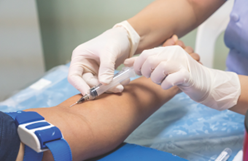Bloodborne Pathogens Training to Support OSHA Compliance
Comprehensive Bloodborne Pathogens (BBP) training, available online, to support your OSHA compliance and workplace safety needs.
Enhance Your Compliance with OSHA’s Bloodborne Pathogens Standard
OSHA requires BBP training as part of the orientation process for new employees and annually as a refresher for all others. Our Steri-Safe® OSHA Compliance Solutions provides access to online trainings that helps to meet the OSHA requirements.
Get A Free Quote
With Steri-Safe OSHA, you get access to our resources for a comprehensive Exposure Control Plan:
- Online Bloodborne Pathogens Training
- OSHA Exposure Control Plan Template
- Online OSHA Trainings and Resources
- Dedicated OSHA Expert
- No Fine. No Fail℠ OSHA Guarantee
- Award Winning
Complete our Bloodborne Pathogens training* to keep you and your staff up to date with the requirements set by the OSHA BBP Standard. The training will cover proper handling of sharps waste and what to do in the event of exposure. Additionally, you will have access to training records for accountability purposes and to present in the event of an OSHA inspection.
*Also available in Spanish
OSHA Exposure Control Plan Template
Customize our Exposure Control Plan template using our OSHA Safety Plan Builder. The template covers key requirements of the plan and allows you to input information specific to your facility.
Online OSHA Trainings and Resources
Access additional OSHA online trainings and compliance resources such as our Hazard Communication Training, our Safety Data Sheets Database, additional safety plan templates and regulatory guidance on our customer portal, MyStericycle.com.
Dedicated OSHA Expert
Book on-site BBP training where our in-house CES will train your staff on the OSHA BBP requirements. They will answer your toughest questions and conduct a detailed mock-OSHA Facility Evaluation to identify any areas of risk.
*For Preferred and Platinum services only.
No Fine. No Fail.SM OSHA Guarantee*
If you follow Stericycle’s program and recommendations and still receive an OSHA citation for violating the federal bloodborne pathogens standard, Stericycle will pay your penalty.**
*For Preferred and Platinum services only.
**Provided additional terms and conditions are satisfied.
Award Winning
Stericycle has been recognized as a Training Industry 2021 Watch List Company in the Employee Health, Safety and Wellness Training category for our OSHA and HIPAA training and compliance solutions portfolio, Steri-Safe®.
Online OSHA Bloodborne Pathogens Training
Complete our Bloodborne Pathogens training* to keep you and your staff up to date with the requirements set by the OSHA BBP Standard. The training will cover proper handling of sharps waste and what to do in the event of exposure. Additionally, you will have access to training records for accountability purposes and to present in the event of an OSHA inspection.
*Also available in Spanish
OSHA Exposure Control Plan Template
Customize our Exposure Control Plan template using our OSHA Safety Plan Builder. The template covers key requirements of the plan and allows you to input information specific to your facility.
Online OSHA Trainings and Resources
Access additional OSHA online trainings and compliance resources such as our Hazard Communication Training, our Safety Data Sheets Database, additional safety plan templates and regulatory guidance on our customer portal, MyStericycle.com.
Dedicated OSHA Expert
Book on-site BBP training where our in-house CES will train your staff on the OSHA BBP requirements. They will answer your toughest questions and conduct a detailed mock-OSHA Facility Evaluation to identify any areas of risk.
*For Preferred and Platinum services only.
No Fine. No Fail.SM OSHA Guarantee*
If you follow Stericycle’s program and recommendations and still receive an OSHA citation for violating the federal bloodborne pathogens standard, Stericycle will pay your penalty.**
*For Preferred and Platinum services only.
**Provided additional terms and conditions are satisfied.
Award Winning
Stericycle has been recognized as a Training Industry 2021 Watch List Company in the Employee Health, Safety and Wellness Training category for our OSHA and HIPAA training and compliance solutions portfolio, Steri-Safe®.








